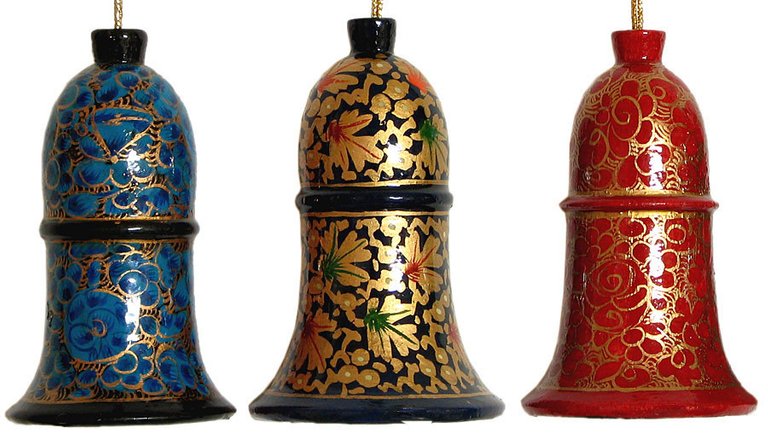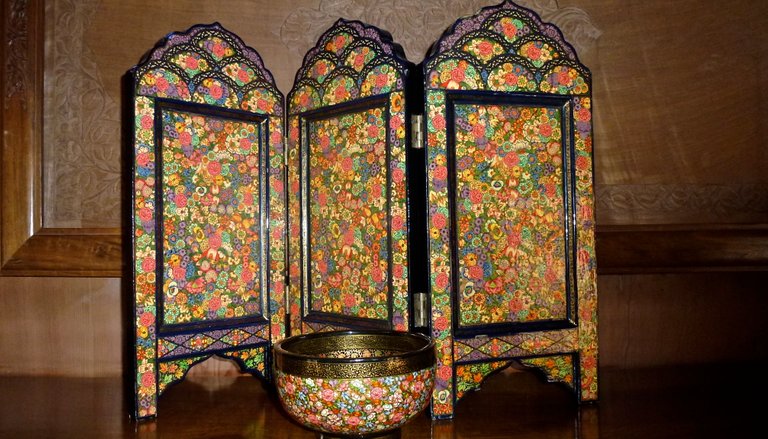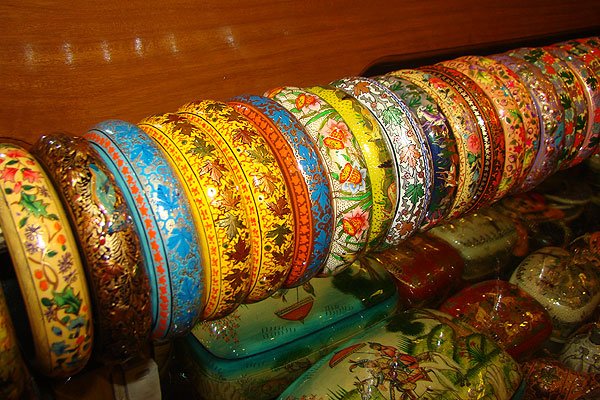
Kari Qalamdane
Hello Dear Friends,
This is my eighth article in my series of Crafts Unparalleled where I discuss incredible Indian craft; artists of these should be celebrated. Today I bring to you a beautifully handcrafted art from the so-called ‘jannat’ (heaven) in India.
Papier Mache is a Kashmiri handcraft that uses paper pulp as a base and then it is richly decorated with drawing with a pen. A range of products are made like boxes, vases, lamp stand, trays, frames, bowls, coasters, and home decor. The art is driven by a dual process of creation of papier Mache products and clearing of forest pine. The word Paper Mache is an adaptation of French Papier Mache, which was used by French trader to define the Kashmiri decorative boxes in which Pashmina was sold.

History of Papier Mache
This craft like many other Indian crafts has its genesis in the 15th century and it hails from Persia. The Indian contact with Persia during this time was crucial for the cross-fertilization of art forms. During the 15th century, Kashmir was under the reign of Zainul-Ab-Din, his reign saw the light of Sufism. There are two anecdotes for the origin of this craft; one where it is believed that Mir Sayyed Ali Hamdani, one of Sufi mystic arrived in Kashmir in the 14th century with several craftsmen who were experts with pulp art. The second anecdote is about Zainul-Ab-Din’s detention in Samarkand in Central Asia, when he returned to kashmir; Iranian artists accompanied him. They settled in Kashmir with the patronage of the king.
The craft is called Kari Qalamdane in Persian and it means pen stand. Initially making of pen stand was the main artifact but later the range of products increased. The craftsmen are called sakhtas. The craft gained popularity as it was replacing the art of drawings on wood with art covering made of pulp. During the Mughal era rule over Kashmir; the craft expanded as a decorative to cover furniture, architecture, and goods of exchange; papier mache was used on woodwork. The few architectural decoration with papier mache are the Madin Sahib Mosque, Shah Hamdan Mosque in Kashmir and the Shalimar Garden in Srinagar.

The Technique
The first step is to obtain pulp for the craft; the main ingredients for this is discarded paper, rice straw, copper sulfate and clothe. Paper is made into pulp by soaking the paper in water for few days then drying it. The dried pulp is then grounded into powder, this power mixed into rice water and then applied to molds. This pulp covering is layered with a muslin cloth and then another layer of plaster (gutchi) is applied to obtain desired surface and shape. The artwork is then removed from the mold and rejoined with a glue. The surface and object are polished for painting.
On this surface, ornamentation is done by naqqahgar, once the surface is covered with a white solution made of gypsum and glue. The colors used in painting are naturally obtained. The object is treated with gold and silver foils along with paste of glue and chalk. The object is dried and surfaces are polished with baked brick. A layer of varnish is used and it is sun-dried and then again painted. A process of repetitive consecutive stages of treatment, ornamentation and sun drying takes place till the final design obtained and painted. Nowadays gems are also etched with pulp.

Sustainable Art
All the colors used are natural, the pen for drawing is made of cat hair or donkey hair. The process involves waste paper. Every piece is a laborious masterpiece with the utmost creativity of the craftsmen. the craft received geographical indication and is also promoted by the government. In Kashmir, schools have courses on this art.
If one visits Kashmir; this is a must-have souvenir.
Image Source:
http://www.kashmirresourcesexposition.com
https://jtdytravels.files.wordpress.comhttp://www.hindustantimes.com
Really wonderful work of art...keep it up. :)
Thank you. Glad you liked it.
Long live teamIndia
thank you for the comment.
Peace, Abundance, and Liberty Network (PALnet) Discord Channel. It's a completely public and open space to all members of the Steemit community who voluntarily choose to be there.Congratulations! This post has been upvoted from the communal account, @minnowsupport, by rainsa from the Minnow Support Project. It's a witness project run by aggroed, ausbitbank, teamsteem, theprophet0, someguy123, neoxian, followbtcnews/crimsonclad, and netuoso. The goal is to help Steemit grow by supporting Minnows and creating a social network. Please find us in the
If you would like to delegate to the Minnow Support Project you can do so by clicking on the following links: 50SP, 100SP, 250SP, 500SP, 1000SP, 5000SP. Be sure to leave at least 50SP undelegated on your account.
Always a pleasure to come to your posts. Keep up
Thank you friends. Always encouraging comments.
Artistic mind....how dow u get such beautiful stuff...?.
Research helps!!!! Anyway i have read indian art and craft.
So beautiful! Did not realize that was paper mache, it looks like it is pottery/ceramic!
Then are they a bit fragile to carry around?
No as i mentioned repeated treatment and layering makes them strong, also most of the time covering is placed on iron and silver objects. The plaster of paris is used for most objects. So they are not at all brittle.
This post has received a 0.81 % upvote from @buildawhale thanks to: @rainsa. Send at least 1 SBD to @buildawhale with a post link in the memo field for a portion of the next vote.
Steem WitnessTo support our daily curation initiative, please vote on my owner, @themarkymark, as a
Lovely art
Thank you. Glad you liked it.
I had no idea that this art-form originated in Persia! I also did not know that such detailed items were made from it! All of the pieces you have pictured here are lovely and remarkable! Thank you for sharing this wonderful and entertaining post! 😊
#steemitbloggers
I know even most Indians don't know about these art pieces. These handicrafts are wonderful for the amount of labor goes in it.
This is why i start this series, you can see previous arts under craftsunparalleled tag and my blog.
I discuss vulnerable crafts to popularize them on global platform.
Thank you for your comment.
That's a very good exposure to people like me! I have always thought it's Turkish arts and never know that it's actually Persians work of arts! I guess it really take a very long time to craft and artist are forging out alot of effort to make a master piece. Thank you for sharing, keep it up! I enjoyed it a lot.
Thank you for the lovely comment. Yes its sheer labor to finish one piece.
I have heard of this technique - papier-mache. But I was not familiar with its history. Your story is very interesting and informative. Thank you,@rainsa
Thank you friend. Glad you liked it.
Beautiful!!
Thank you.
STEEM WitnessYou got a 5.21% upvote from @upme requested by: @rainsa. Send at least 1.5 SBD to @upme with a post link in the memo field to receive upvote next round. To support our activity, please vote for my master @suggeelson, as a
Whoa. That is some gorgeous artwork! I love that it is sustainable. I've done a lot with paper mache in my life, but nothing even CLOSE to this beautiful art! Amazing. Thank you for sharing.
Wowww beautiful. I had no idea this could be made with paper mache that's so amazing